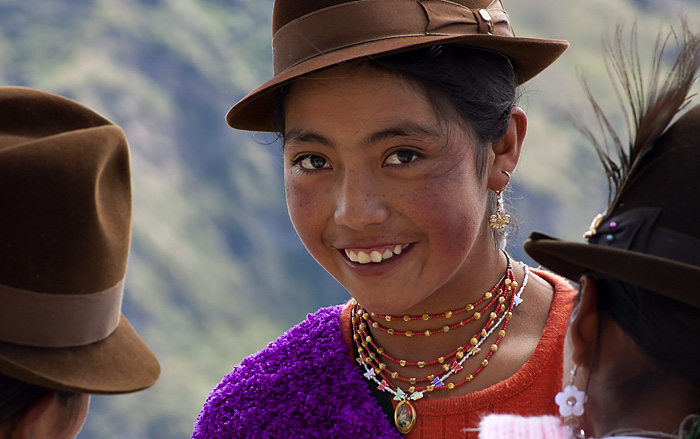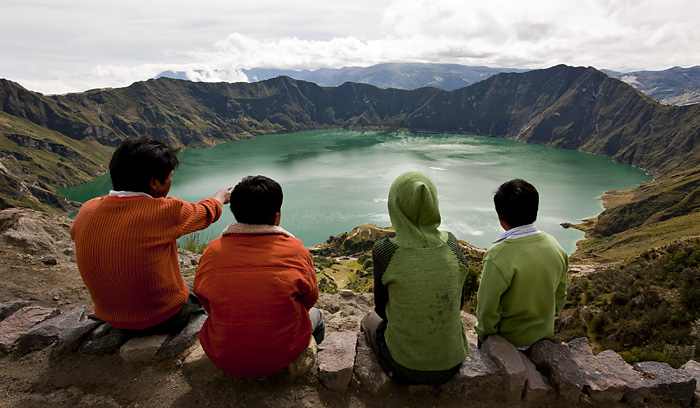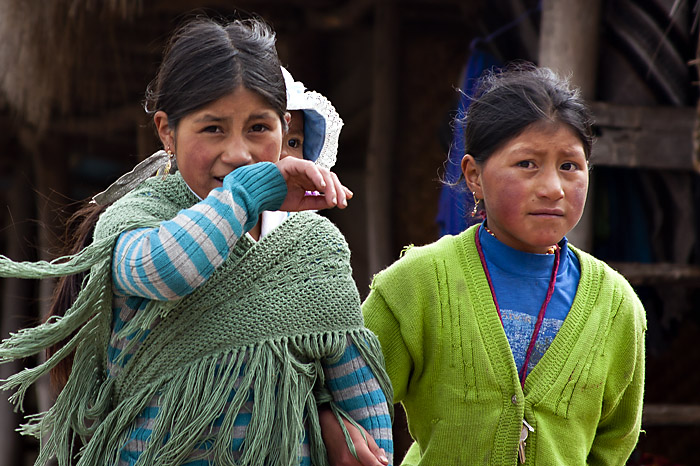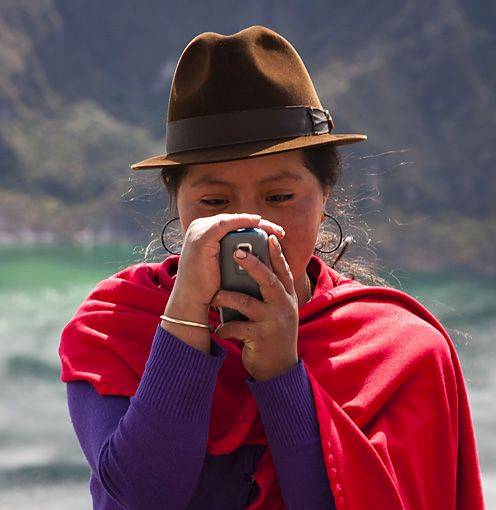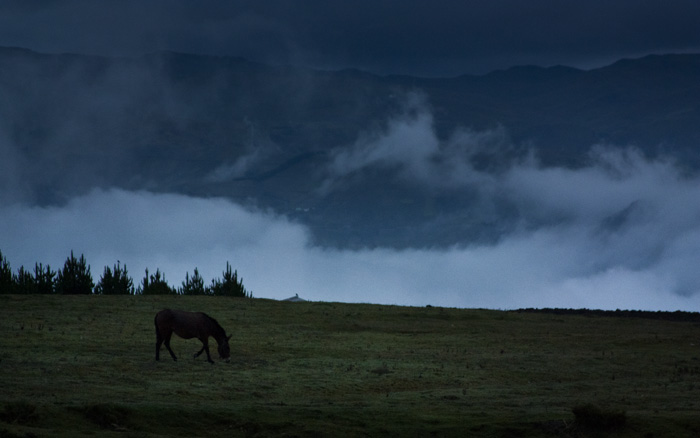Faithful disciples, here He is again ![]() . This time He will tell you of a spectacular lake inside a volcanic crater and Banos, a tourist place with thermal baths.
. This time He will tell you of a spectacular lake inside a volcanic crater and Banos, a tourist place with thermal baths.
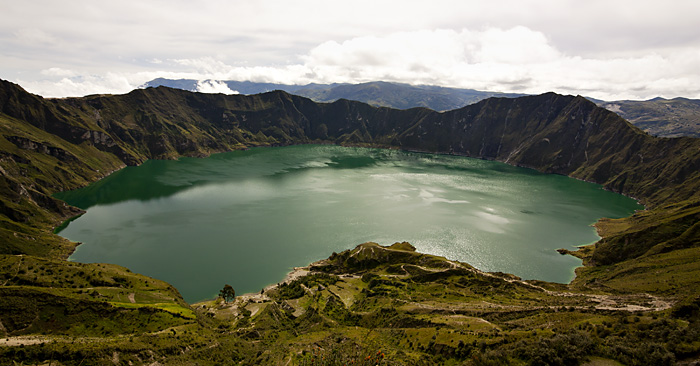 The lake Quilotoa was formed by the collapse of a volcano about a thousand years ago. The volcano has a diameter of 3.15 km and is still active. The last eruption occurred in 1799.
The lake Quilotoa was formed by the collapse of a volcano about a thousand years ago. The volcano has a diameter of 3.15 km and is still active. The last eruption occurred in 1799.
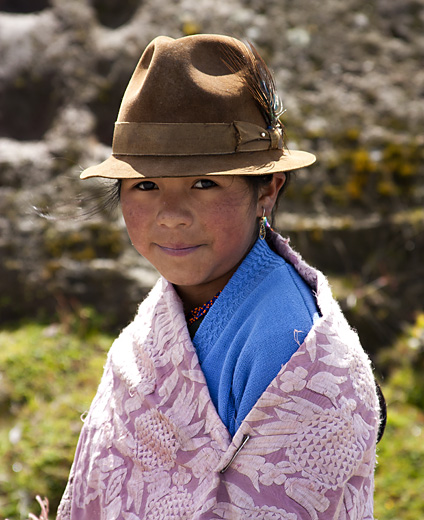 Most of the local women and girls wear a felt hat, even in the house.
Most of the local women and girls wear a felt hat, even in the house.
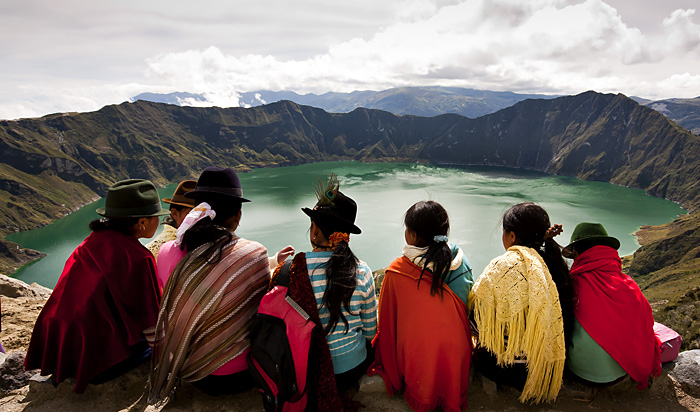 25% of the Ecuadorian population is indigenous, composed of 13 autochthonous communities. The descendants of the Incas form the largest of these communities. They are called Kichwa, as their language, used today by about two and a half million people. The Kichwa is part of the Quechua languages, spoken by over 7 million people in Ecuador, Peru, and Colombia.
25% of the Ecuadorian population is indigenous, composed of 13 autochthonous communities. The descendants of the Incas form the largest of these communities. They are called Kichwa, as their language, used today by about two and a half million people. The Kichwa is part of the Quechua languages, spoken by over 7 million people in Ecuador, Peru, and Colombia.
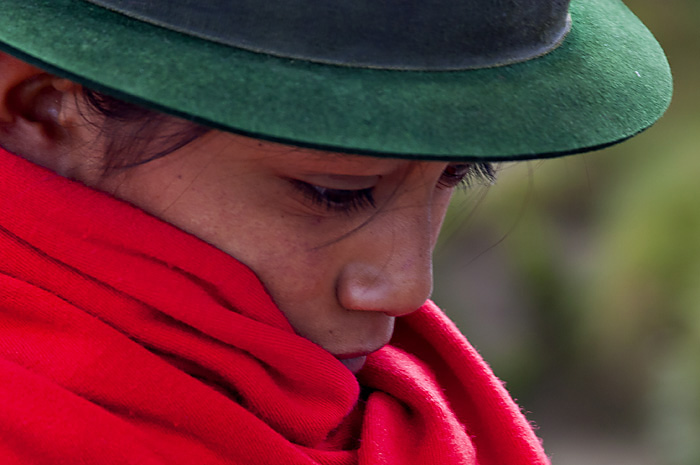 Little girl. Other photos of boys and girls follow.
Little girl. Other photos of boys and girls follow.
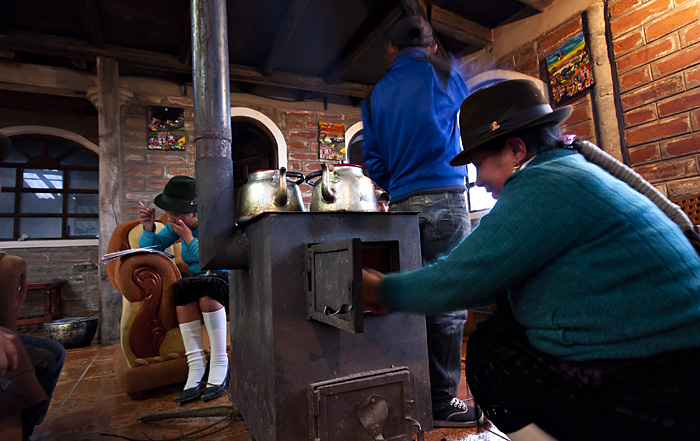 The family that ran the posada where I stayed, near the lake. I slept in a nearby house, barely warmed by a small wood-burning stove. During the night, after the fire run out, it was very cold.
The family that ran the posada where I stayed, near the lake. I slept in a nearby house, barely warmed by a small wood-burning stove. During the night, after the fire run out, it was very cold.
There I read a little book for children in Kichwa, Spanish and English, very well illustrated, about a Kichwa legend, the legend of the condor in love. I’ll give you a summary:
The spirit Pachakama created the universe. After that, he realized that he needed a flying messenger to communicate with the Earth.
Together with his companion Pachamama, the female spirit of fertility, and other forces of the universe (Sun, Moon, etc…), he created an egg. From it came out a little condor.
The condor immediately began to do his duty, sending messages and receiving inquiries from Earth. He used the kipus, ie colored cords, and dreams to communicate.
But after few years, the condor began to feel lonely. “Everyone has a partner, even the rabbits, only I am alone…”. So, he started to seek love.
Fluttering above the Andes, he saw a girl who grazed sheep. He immediately fell in love and, after stealing a poncho to look more beautiful, approached her.
She mistook him for a guy with pants to his knees, and after speaking at length, she fell in love as well.
Once she realized he was a condor, she was taken away from him, flying. In the beginning, she was a little scared. Still, soon she became delighted by the places below: the lake Quilotoa, the picks of Ilizinas, the Chimborazo, and the sacred volcanoes Cotopaxi and Tungurahua.
Eventually, they arrived on a kunturmatzi, one of the quarries in the high Andes, where the condor lives. He pecked her lovingly and, with each peck, feathers grew on the girl.
At her home, meanwhile, were worried. It was already night and the dog, who had seen where they went, drove the girl’s family and the entire village to the nest of the condor. Once there, the villagers sent away the condor and recovered the girl.
Back in her house, the parents locked her inside, but the girl, burning some straw, managed to send a message to the condor, which came back and took her again with him.
This time they flied up until a very high kunturmatzi. There, the condor pecked her lovingly, and feathers grew on her. When the villagers reached this nest, she was already completely transformed into a bird, a female condor, and her parents had to accept the fate. Pachakama and Pachamama were happy about this because from now on, there is a greater connection with the people of Earth to send and receive messages.
And still nowadays, when a girl goes to graze, the parents warn her: “Beware of the condor!”
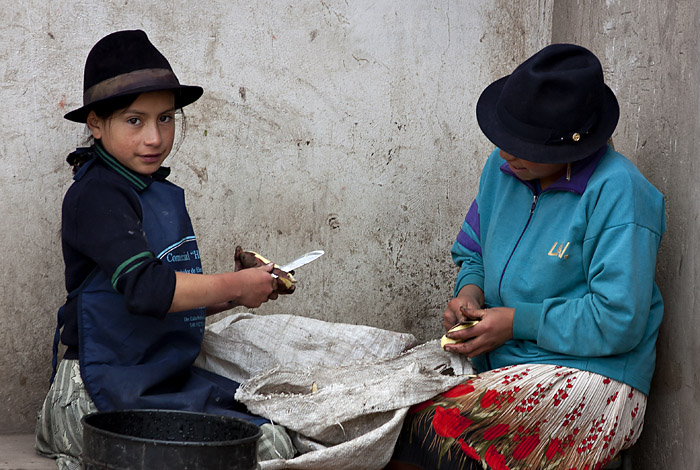 Little girls peel potatoes in Zumbahua, the closest town to Lake Quilotoa.
Little girls peel potatoes in Zumbahua, the closest town to Lake Quilotoa.
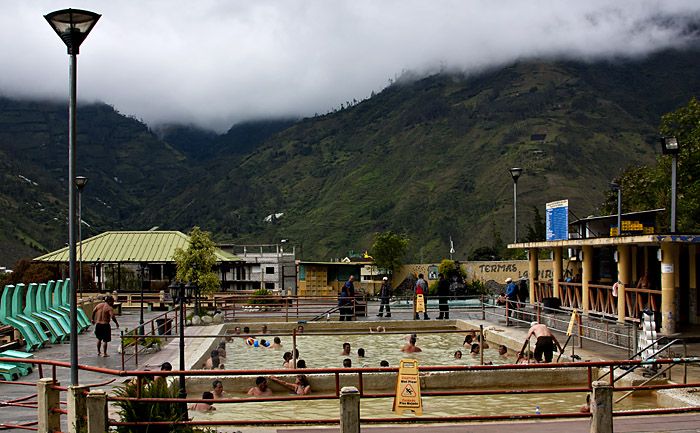 Banos it’s a peaceful resort, surrounded by steep mountains all around. One of its main attractions is the thermal baths.
Banos it’s a peaceful resort, surrounded by steep mountains all around. One of its main attractions is the thermal baths.
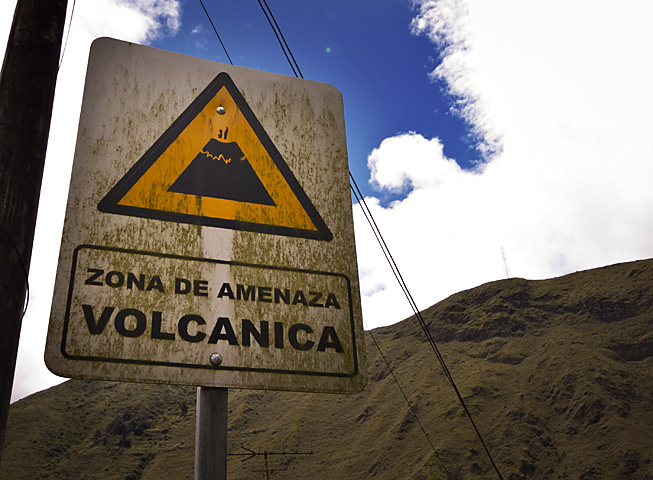 Ecuador is full of volcanoes, including Chimborazo, 6310 meters, no longer active, and the Taita Cotopaxi, 5897 meters, one of the highest active volcanoes in the world, a sacred place of the Andean Kichwa.
Ecuador is full of volcanoes, including Chimborazo, 6310 meters, no longer active, and the Taita Cotopaxi, 5897 meters, one of the highest active volcanoes in the world, a sacred place of the Andean Kichwa.
The volcano near Banos is Tungurahua. And I’ve just discovered something curious: looking now on the Internet to see when it erupted last time I found that happened three days ago, on April 30, when I was already here! (link: http://www.volcanodiscovery.com/tungurahua/news.html ). It seems there were earthquakes, tremors, pillars of smoke, ashes, but I haven’t noticed anything!
 In Banos, it is possible to do many activities like rafting, climbing the canyon, bungee jumping, etc. … I did the “canopy” (as this Argentinian guy in the photo), which consists of flying down into the valley, hooked on a wire cable.
In Banos, it is possible to do many activities like rafting, climbing the canyon, bungee jumping, etc. … I did the “canopy” (as this Argentinian guy in the photo), which consists of flying down into the valley, hooked on a wire cable.
I had done it already in Warsaw, where, however, the route was short and the scenery not spectacular.
Here the cable was 1 km long, and the flight lasted about a minute. Unlike what you might think, it was not a scary experience, and, actually, it was relaxing. I flew silently, just above a river.
Anyway, I don’t think that the mandatory helmet would help if falling from that height.
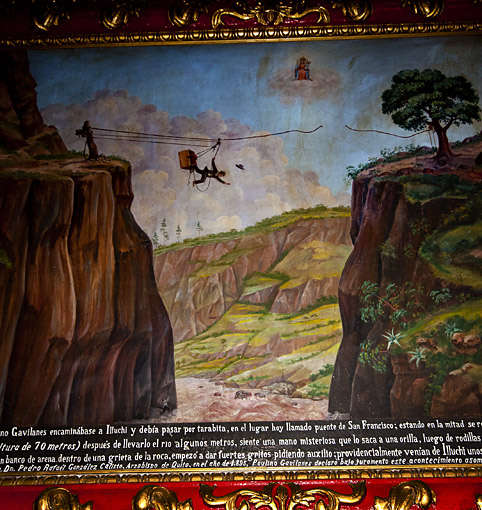 Later, I discovered that more than a helmet, I could have been saved by a magic spell, as you can see in this painting in the main church of Banos. In fact, back in June 1889, something similar happened to Mr. Paulino Gavilanes. However, after pronouncing the words “Madre mia de Agua Santa” (“Mother of the Holy Water”), he was caught and carried to safety by the Holy Virgin.
Later, I discovered that more than a helmet, I could have been saved by a magic spell, as you can see in this painting in the main church of Banos. In fact, back in June 1889, something similar happened to Mr. Paulino Gavilanes. However, after pronouncing the words “Madre mia de Agua Santa” (“Mother of the Holy Water”), he was caught and carried to safety by the Holy Virgin.
Well, we must recognize that the legend of the condor is much better than this bullshit.
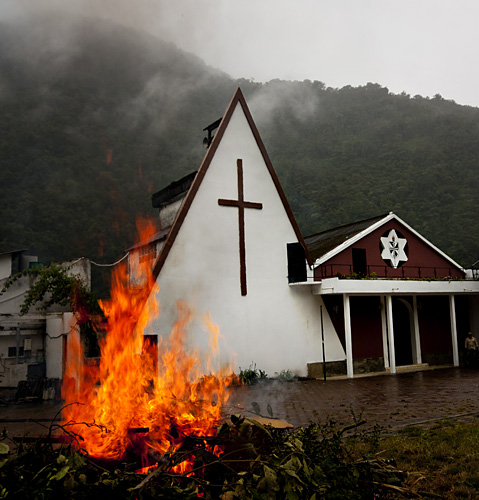 An odd church on the road that, from the mountains of Banos, goes down for about 40 km to the forest. Full of waterfalls and beautiful scenery. It is enjoyable to do on a bike, also because it is mostly downhill.
An odd church on the road that, from the mountains of Banos, goes down for about 40 km to the forest. Full of waterfalls and beautiful scenery. It is enjoyable to do on a bike, also because it is mostly downhill.
And for coming back up? To come back, I hitched a ride on a truck. Eeeehhhh, not stupid dekaro! ![]()
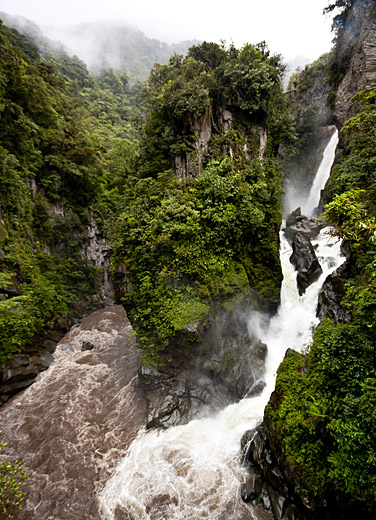 The most beautiful place along the way is the Diablo (devil) waterfall.
The most beautiful place along the way is the Diablo (devil) waterfall.
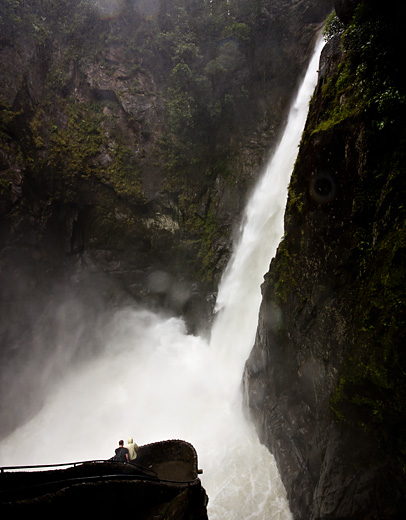 You can get very close, up to where the water springs. It’s impossible to describe the feeling of strength and energy that emanates the jet. It was at its fullest because we are at the end of the rainy season (and in fact, since I arrived in Ecuador, is raining a lot).
You can get very close, up to where the water springs. It’s impossible to describe the feeling of strength and energy that emanates the jet. It was at its fullest because we are at the end of the rainy season (and in fact, since I arrived in Ecuador, is raining a lot).
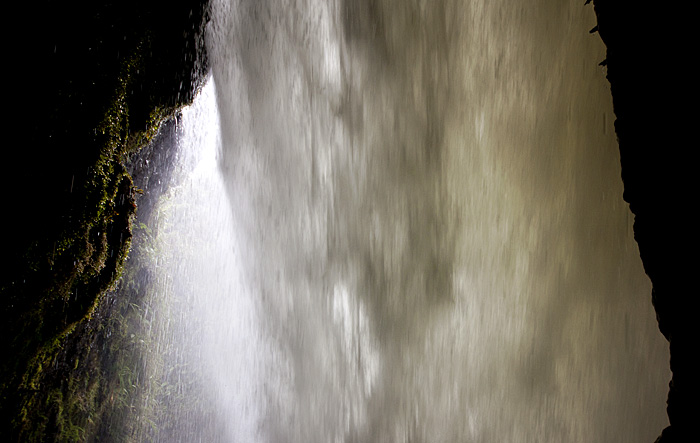 Crawling under a path inside the rock, you can reach a small area behind the waterfall. There, you feel blended with the mighty force of nature, a continuous roar, almost mesmerizing.
Crawling under a path inside the rock, you can reach a small area behind the waterfall. There, you feel blended with the mighty force of nature, a continuous roar, almost mesmerizing.
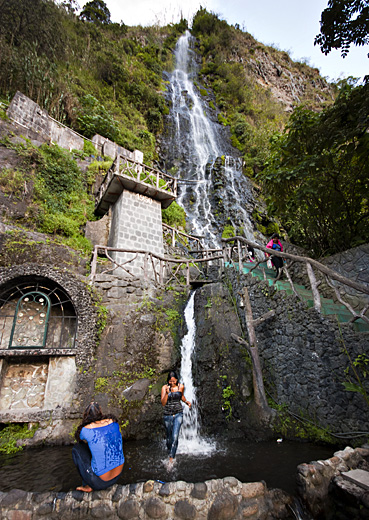 This is, instead, the cascade of the Virgin of holy water, and, indeed, compared to that of Diablo, is docile and shy. It is located right next to the thermal baths of Banos.
This is, instead, the cascade of the Virgin of holy water, and, indeed, compared to that of Diablo, is docile and shy. It is located right next to the thermal baths of Banos.
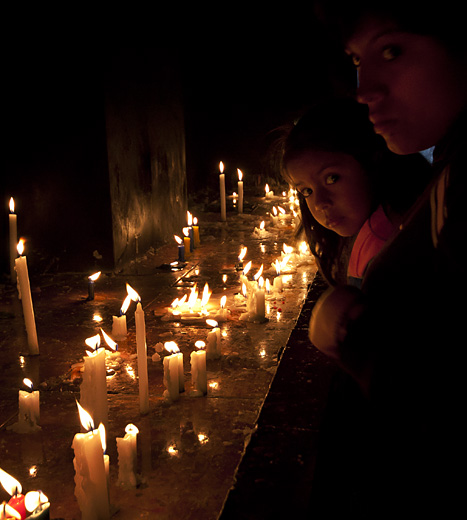 Candles in honor of the Virgin of Holy Water in the main church of Banos.
Candles in honor of the Virgin of Holy Water in the main church of Banos.
And that’s all for this time. Kisses! ![]()






















































